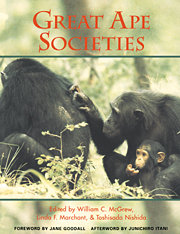Book contents
- Frontmatter
- Contents
- List of contributors
- Preface
- Foreword: conserving great apes
- Part I Apes overviewed
- 1 Toward an understanding of the orangutan's social system
- 2 Comparative socio–ecology of gorillas
- 3 Comparative socio–ecology of Pan paniscus
- Part II Social ecology
- Part III Social relations
- Part IV Minds
- Part V Apes compared
- Part VI Modeling ourselves
- Afterword: a new milestone in great ape research
- Appendix: great ape study sites
- Index
2 - Comparative socio–ecology of gorillas
Published online by Cambridge University Press: 04 August 2010
- Frontmatter
- Contents
- List of contributors
- Preface
- Foreword: conserving great apes
- Part I Apes overviewed
- 1 Toward an understanding of the orangutan's social system
- 2 Comparative socio–ecology of gorillas
- 3 Comparative socio–ecology of Pan paniscus
- Part II Social ecology
- Part III Social relations
- Part IV Minds
- Part V Apes compared
- Part VI Modeling ourselves
- Afterword: a new milestone in great ape research
- Appendix: great ape study sites
- Index
Summary
INTRODUCTION
Great apes have remarkably diverse social systems. For example, only in gorillas do females live in stable, cohesive groups and associate permanently with males and do males show conditional dispersal. However, all apes show female dispersal from natal groups or home ranges and are nonfemale bonded (sensu Wrangham, 1980). Female African great apes transfer directly between groups or communities, behavior unusual in gregarious mammals (Greenwood, 1980; Pusey & Packer, 1987). These and other contrasts and similarities raise questions about variation in the costs and benefits of group living, of permanent malefemale association, and of dispersal and philopatry (Wrangham 1979, 1980, 1982, 1987; van Schaik, 1989).
Here, I review aspects of gorilla ecology, life history strategies and mating tactics, and social relationships, with a focus on the ecology of female social relationships and on female transfer. I mostly cover mountain gorillas (Gorilla gorilla beringei, ‘MGs’ below), represented by the 10–20% of the Virungas population studied at the Karisoke Research Centre, Rwanda, since 1967. Few comparable data exist on social behavior for western (Gorilla gorilla gorilla; ‘WLGs’ below) and eastern lowland gorillas (Gorilla gorilla graueri; ‘ELGs’ below), but subspecific differences in dispersal costs are probably small despite ecological variation.
Sex biases in mammalian dispersal
Explanations for why most males disperse, and why most females are philopatric, in most mammals, invoke multiple factors (Greenwood, 1980; Dobson, 1982; Moore & Ali, 1984; Dobson & Jones, 1986; Johnson, 1986; Pusey & Packer, 1987).
- Type
- Chapter
- Information
- Great Ape Societies , pp. 16 - 28Publisher: Cambridge University PressPrint publication year: 1996
- 95
- Cited by

